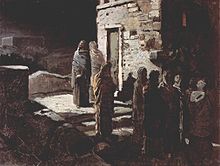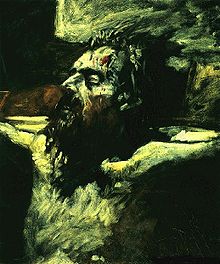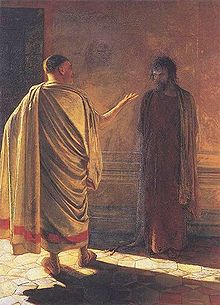- Nikolai Ge
-
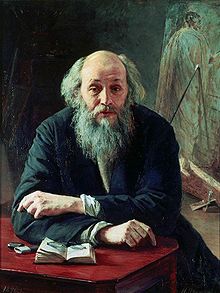 Nikolai Ge, portrait by Nikolai Yaroshenko
Nikolai Ge, portrait by Nikolai Yaroshenko
Nikolai Nikolaevich Ge (or Ghe, sometimes spelled Gay, Russian: Николай Николаевич Ге; 27 February [O.S. 15 February] 1831 – 13 June [O.S. 1 June] 1894) was a Russian realist painter famous for his works on historical and religious motifs.
Contents
Early life and education
Nikolai Ge was born in Voronezh to a Russian noble family of French origin. His grandfather emigrated to Russia in the 18th century. His parents died when he was still a child, so Nikolai was raised by his serf nurse. He graduated from the First Kiev Gymnasium and studied at the physics-mathematics department of Kiev University and Saint Petersburg University.
Career as an artist
In 1850 he gave up his career in science and entered the Imperial Academy of Arts in Saint Petersburg. He studied in academy under the historical painter Pyotr Basin until 1857. He graduated from the academy in 1857 with a gold medal for his painting The Witch of Endor Calling Up the Spirit of the Prophet Samuel. According to Ge himself, during that period he was strongly influenced by Karl Briullov.
His gold medal provided him a scholarship for studying abroad . He visited Germany, Switzerland, France and in 1860 settled in Italy. In Rome he met Alexander Andreyevich Ivanov who strongly influenced Ge.
In 1861 Ge painted The Last Supper; using the image for his central figure of Christ a photograph taken by the famous Russian photographer Count Sergei Lvovich Levitsky (1819-1898) of Levitsky's cousin Aleksandr Ivanovich Herzen (1812-1870); the pro-Western writer and outstanding public figure.
Ge would recall, "I wanted to go to London to paint Herzen's portrait,... and he responded to my request with a large portrait by Mr. Levitsky". The final painting's similarity between the pose of Levitsky's photo of Herzen and Ge's pose of the painted Christ led the press of the day to exclaim the painting as "a triumph of materialism and nihilism".
It is the first time photography became the main starting point for the solution to a central character of a painting and speaks to the deep influences that photography would have later on in art and movements like French Impressionism.
The painting (bought by Tsar Alexander II of Russia) made such a strong impression when it was shown in Saint Petersburg in 1863 that Ge was made a professor of Imperial Academy of Arts.
In 1864 Ge returned to Florence and would paint not only Herzen's portrait but also the Messengers of the Resurrection and the first version of the Christ on the Mount of Olives. The new religious paintings at that time were not much of a success, and the Imperial Academy refused to exhibit them in its annual exhibition.
In 1870 Ge again returned to Saint Petersburg there he turned to Russian history for subject matter. The painting Peter the Great Interrogates Tsarevich Alexey at Peterhof (1871) was a great success, but other historical paintings were met without interest. Ge took the cold response to his work very hard. He wrote that a man should live by doing agricultural work, and the art should not be for sale. He bought a small khutor (farm) in Chernigov gubernia (currently Ukraine) and moved there. He became acquainted with Leo Tolstoy and became an enthusiastic follower of his philosophy.
In the early 1880s he returned to art producing religious paintings and portraits. He stated that everybody has a right to have a portrait so he agreed to work for whatever low commission the subject could afford. Among his portraits of the time was his famous portrait of Leo Tolstoy, portrait of Mikhail Saltykov-Shchedrin and many others.
His late paintings on New Testament subjects of that period were praised by liberal critics like Vladimir Stasov, criticized by conservatives as illustrating Ernest Renan rather than the New Testament and forbidden by the authorities for blasphemy. Quod Est Veritas? Christ and Pilate (1890) was expelled from the exhibition; The Judgment of the Sanhedrin: He is Guilty! (1892) was not admitted to the annual Academy of Arts exhibition; The Calvary (Golgotha) (1893) remained unfinished; The Crucifixion (1894) was banned by Tsar Alexander III.
Ge died on his farm in 1894.
After his death
The fate of many of his works remains a mystery. At the end of his life Ge bequeathed all of his works to his Swiss benefactress Beatrice de Vattville (Russian: Беатриса де Ваттвилль, владелица замка Жэнжэн в кантоне Во в Швейцарии) in exchange for a small rent during his lifetime. She died in 1952 but none of Ge's work were found in her castle. Among the lost works is Ge's supposedly magnum opus painting The Crucifixion. Ge's drawings were found by art collectors in Swiss secondhand stores as late as 1974.[1]
Selected works
-
Alexander Herzen, 1864
-
Peter the Great Interrogating the Tsarevich Alexei Petrovich at Peterhof, 1871
-
Conscience: Judas
-
Leo Tolstoy, 1882
-
Sophia Tolstaya (wife of Leo Tolstoy)
References
- ^ Ge in Yakov Krotov library (Russian)
External links and references
- Biography
- Peredvizhniki
- Biography (Russian)
People from Russia Leaders and religious - Pre-1168
- 1168–1917
- 1922–1991
- 1991–present
- RSFSR leaders
- General secretaries
- Soviet premiers (1st deputies)
- Soviet heads of state (and their spouses)
- Prime ministers (1st deputies)
- Foreign ministers
- Prosecutors general
- Metropolitans and patriarchs
- Saints
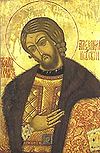
Military and explorers - Field marshals
- Soviet marshals
- Admirals
- Aviators
- Cosmonauts
Scientists and inventors - Aerospace engineers
- Astronomers and astrophysicists
- Biologists
- Chemists
- Earth scientists
- Electrical engineers
- IT developers
- Linguists and philologists
- Mathematicians
- Naval engineers
- Physicians and psychologists
- Physicists
- Weaponry makers
Artists and writers Sportspeople - Chess players
Categories:- 1831 births
- 1894 deaths
- People from Voronezh
- Realist painters
- Russian painters
- Russian artists
Wikimedia Foundation. 2010.


